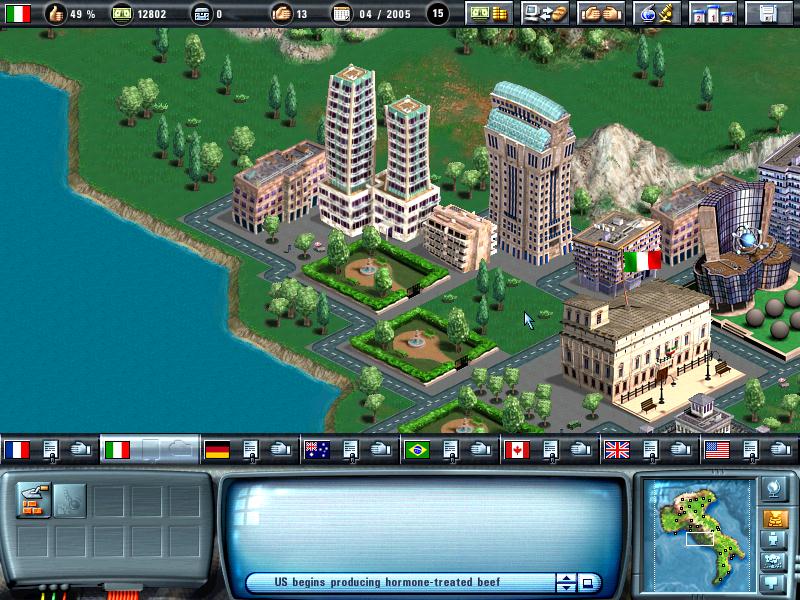National Political Index: Political Games And Simulations
Soldiers from Britain's Royal Artillery train in a 'virtual world' during Exercise Steel Sabre, 2015Military simulations, also known informally as war games, are in which theories of warfare can be tested and refined without the need for actual hostilities. Military simulations are seen as a useful way to develop, and solutions, but critics argue that the conclusions drawn from such models are inherently flawed, due to the approximate nature of the models used. Many professional analysts object to the term wargames as this is generally taken to be referring to the, thus the preference for the term simulation.Simulations exist in many different forms, with varying degrees of realism.
In recent times, the scope of simulations has widened to include not only but also and factors, which are seen as inextricably entwined in a realistic warfare model. Whilst many governments make use of simulation, both individually and collaboratively, little is known about it outside professional circles. Yet modelling is often the means by which governments test and refine their military and political policies. Military simulations range from field exercises through computer simulations to analytical models; the realism of live manoeuvres is countered by the economy of abstract simulations.The term military simulation can cover a wide spectrum of activities, ranging from, to abstract computerized models that can proceed with little or no human involvement—such as the (RSAC).As a general scientific principle, the most reliable data comes from actual observation and the most reliable theories depend on it. This also holds true in military analysis, where analysts look towards live field-exercises and trials as providing data likely to be realistic (depending on the realism of the exercise) and verifiable (it has been gathered by actual observation). At the Battle of the River Plate in 1939. As predicted by Pratt's naval warfare model, despite taking heavy damage the lighter British cruisers were able to defeat their much larger opponent, the German battleship Admiral Graf Spee.Developing realistic models has proven to be somewhat easier in simulations than on land.
One of the pioneers of naval simulations, designed his 'Naval War Game' in the late 1930s, and was able to validate his model almost immediately by applying it to the encounter between the German and three British in the off in 1939. A mock-up of at Pearl Harbor. This image was recreated for a later Japanese film.Although fictional, the above scenario may however have been based on fact.
The extensively wargamed their planned expansion during World War II, but map exercises conducted before the were frequently stopped short of a conclusion where Japan was defeated. One often-cited example prior to had the umpires magically resurrecting a Japanese carrier sunk during a map exercise, although Professor Robert Rubel argues in the their decision was justified in this case given improbable rolls of the dice. Given the historical outcome, it is evident the dice rolls were not so improbable, after all. There were however equally illustrative fundamental problems with other areas of the simulation, mainly relating to a Japanese unwillingness to consider their position should the element of surprise, on which the operation depended, be lost.Tweaking simulations to make results conform with current political or military thinking is a recurring problem.
In US Naval exercises in the 1980s, it was informally understood no high-value units such as aircraft carriers were allowed to be sunk, as naval policy at the time concentrated its interest on such units. The outcome of one of the largest ever NATO exercises, Ocean Venture-81, in which around 300 naval vessels, including two carrier battle groups, were adjudged to have successfully traversed the and reached the despite the existence of a (real) 380-strong Soviet submarine fleet as well as their (simulated) Red Team opposition, was publicly questioned in, the professional journal of the US Naval Institute. The US Navy managed to get the article classified, and it remains secret to this day, but the article's author and chief analyst of Ocean Venture-81, Dean L.

Knuth, has since claimed two Blue aircraft carriers were successfully attacked and sunk by Red forces.There have been many charges over the years of computerised models, too, being unrealistic and slanted towards a particular outcome. Critics point to the case of military contractors, seeking to sell a weapons system. For obvious reasons of cost, weapons systems (such as an air-to-air missile system for use by fighter aircraft) are extensively modelled on computer. Without testing of their own, a potential buyer must rely to a large extent on the manufacturer's own model. This might well indicate a very effective system, with a high kill probability ( ).
However, it may be the model was configured to show the weapons system under ideal conditions, and its actual operational effectiveness will be somewhat less than stated. The US Air Force quoted their missile as having a Pk of 0.98 (it will successfully destroy 98% of targets it is fired at). In operational use during the in 1982, the British recorded its actual Pk as 0.78.Another factor that can render a model invalid is human error.
One notorious example was the US Air Force's Advanced Penetration Model, which due to a programming error made US bombers invulnerable to enemy air defences by inadvertently altering their or when checking their location for a missile impact. This had the effect of ' the bomber, at the instant of impact, hundreds or even thousands of miles away, causing the missile to miss.
Furthermore, this error went unnoticed for a number of years. Other unrealistic models have had battleships consistently steaming at seventy knots (twice their top speed), an entire tank army halted by a border police detachment, and attrition levels 50% higher than the numbers each force began with.Issues of enemy technical capability and military philosophy will also affect any model used. Whilst a modeller with sufficiently high security clearance and access to the relevant data can expect to create a reasonably accurate picture of his own nation's military capacity, creating a similarly detailed picture for a potential adversary may be extremely difficult. Military information, from technical specifications of weapons systems to tactical doctrine, is high on the list of any nation's most closely guarded secrets.
However, the difficulty of discovering the unknown, when it is at least known that it exists, seems trivial compared to discovering the unguessed. As famously pointed out in Spy Story, if the enemy has an unanticipated capability (and he almost always does), it may render tactical and strategic assumptions so much nonsense. Lyndon Johnson and aides examining a model of during the.All the above means that models of warfare should be taken for no more than they are: a non-prescriptive attempt to inform the decision-making process. The dangers of treating military simulation as gospel are illustrated in an anecdote circulated at the end of the Vietnam War, which was intensively gamed between 1964 and 1969 (with even President being photographed standing over a wargaming sand table at the time of ) in a series of simulations codenamed Sigma. Medal of honor breakthrough 2.4 patch. The period was one of great belief in the value of military simulations, riding on the back of the proven success of (or OR) during World War II and the growing power of computers in handling large amounts of data.The story concerned a fictional aide in 's administration, who, when Nixon took over government in 1969, fed all the data held by the US pertaining to both nations into a computer model—population, gross national product, relative military strength, manufacturing capacity, numbers of tanks, aircraft and the like.
The aide then asked the question of the model, 'When will we win?' Apparently the computer replied, 'You won in 1964!'
See also. (MORS).Notes and references. Taylor, Modeling and Simulation of Land Combat, ed. Callahan, Georgia Institute of Technology, Atlanta, GA, 1983. 2008-06-15 at the. H.
National Political Index: Political Games And Simulations For Kids
Hall, Norman Shapiro, Herbert J Shukiar, Overview of RSAC System Software: A Briefing, RAND Corporation, 1993,. 'Exercises are generally the largest, in terms of cost and personnel, of the many types of U.S.
Military deployments for training.' .: 'There was near universal agreement that Prussia's victories were due to generalship.
This advantage in generalship was produced by her War College and her general staff system, and behind the success of both stood wargaming.' . Andrew Wilson, The Bomb and the Computer (London: Barrie & Rockliff, Cresset P, 1968), p.6. Edgardo B. Matute, 'Birth and Evolution of War Games', Military Review 50, No. 53.
Thomas B. Allen, War Games: Inside the Secret World of the Men who Play at Annihilation, New York, McGraw Hill, 1987, p. 141.
A situation common in sophisticated civilian games. Thomas B Allen, War Games: Inside the Secret World of the Men who Play at Annihilation, New York, McGraw Hill, 1987, pp.11–20, describing a wargame the author was permitted to observe. It also resembles simulations prepared and broadcast by ABC-TV's. Allen, op. Cit., p.328.
F W Lanchester, Aircraft in War: The Dawn of the Fourth Arm, Lanchester Pr Inc, 1999,. Reprint of the original 1916 issue. A F Karr, Lanchester Attrition Processes and Theater-Level Combat Models, Mathematics of Conflict, Elsevier Science Publishers B V, 1983,. Thomas B. Allen, War Games: Inside the Secret World of the Men who Play at Annihilation, New York, McGraw Hill, 1987, p. 332.
von Clausewitz, Carl (trans. On War, Wordsworth, 1997,. Thomas B. Allen, War Games: Inside the Secret World of the Men who Play at Annihilation, New York, McGraw Hill, 1987, p. 120. Allen, War Games, p.122.
Allen, War Games, p.148. Allen, War Games, p.
152. ^ Allen, War Games. Allen, War Games, Chapter 11: 'Red and Blue in the White House'. Allen, War Games, p.33. Allen, War Games, p.215. 2007-04-14 at the.
Allen, War Games, p. 123. Fletcher Pratt, Fletcher Pratt's Naval War Game, New York, Harrison-Hilton Books, 1940, Out of print. Trevor N Dupuy, Numbers, Predictions, and War, Indianapolis, IN: Bobbs-Merrill Company, 1979, p57.
Trevor N Dupuy, Numbers, Predictions and War, Indianapolis, IN: Bobbs-Merrill Company, 1979, p41. Allen, War Games, p. 129. Tom Clancy, Red Storm Rising, HarperCollins, 1988,. Mitsuo Fuchida, Midway: The Battle That Doomed Japan, Naval Institute Press (new edition), 2001, pp.96-97. Thomas B.
Cit., p.288. ibid., p.289. Professor Roger Thompson, Professor of Military Studies, Knightsbridge University, in a discussion paper, Is the US Navy Overrated?, 2005, listed in the German Armed Forces Institute for Social Research (Sozialwissenschaftliches Institut Der Bundeswehr) Database on Military Sociological Studies. Allen, op. Cit., p.290. Not unlike what Nicholas Palmer in Gamer's Guide to Board Wargaming called a fashionable fantasy touch of a 'Sprouts wings' spell.


^ Allen, War Games, p. 317. Allen, op.
Cit., p.93. 2007-09-29 at the.
David Halberstam, The Best and the Brightest, Ballantine Books, 1993 (20th anv edition),. Andrew Wilson, The Bomb and the Computer, London, Barrie & Rockliff, Cresset P, 1968,. Harry G. Summers, On Strategy: A Critical Analysis of the Vietnam War, Presidio Press, 1982,.Further reading. Thomas B Allen, War Games: Inside the Secret World of the Men who Play at Annihilation, New York, McGraw Hill, 1987,. Arthur Filippidis et al., Simulation Activities using Gateway and Tactical Digital Information Links.